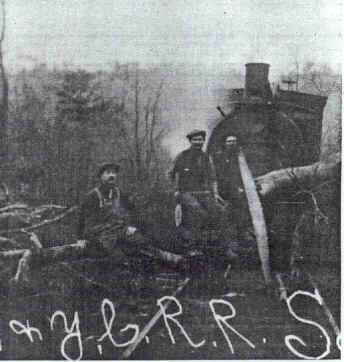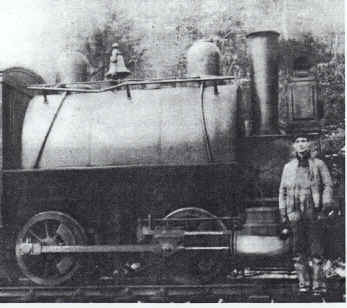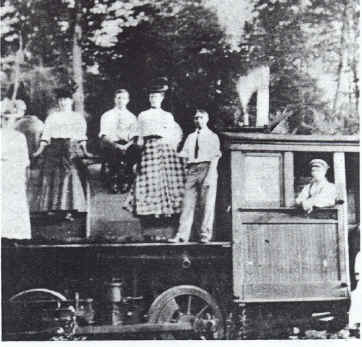More about the history of the Blacklick and Yellow Creek Railroad and the Cambria and Indiana Railroad
taken from the book Delano's Domain: A History of Warren Delano's Mining Towns of Vintondale, Wehrum and Claghorn, Volume I, 1789 - 1930
by Denise Weber. Reprinted by permission of the author.

1906 photo of a scene on the Blacklick and Yellow Creek Railroad. Courtesy of Leona Clark Dusza.
The Blacklick and Yellow Creek Railroad
In addition to getting the logs to the mill, shipping the finished lumber also presented problems to the Vinton Lumber Company (VLC) in 1899-1900. The Ebensburg and Blacklick branch of the PRR extended only to Vintondale at that time. To get to the freight station, lumber had to be hauled by horse and wagon, fording the Blacklick at a low spot. To facilitate shipping, the VLC made an agreement with the Ebensburg and Blacklick Railroad for the construction of a railroad to the mill. A third party in the agreement, the PRR, was to furnish the rails when the roadbed was done. At the same time, rights of way were purchased by the VLC to construct a logging railroad along the north branch of the Blacklick. Construction of a permanent railroad rather than a tramway probably was done to exploit the coal deposits in addition to the timber.
To complete the connection of the railroads, Blair Shaffer sold the Ebensburg and Blacklick Railroad two strips of land totaling 1.824 acres in December, 1901 for $500. The mineral rights for these two strips remained in the hands of the Cambria Iron Company. The lumber company also agreed to grant a release to its timbering rights on the strips to the railroad for $1.
On June 15, 1904, the Blacklick and Yellow Creek Railroad was chartered in Harrisburg. L.H. Davis was the superintendent of the B&YC; he was also one of the first automobile owners in Vintondale, purchasing a 1909 Model 10 Buick Runabout from the newly formed Indiana Motor Company.

1907 B&YC locomotive and engineer, courtesy L.C. Dusza.
Railroad Equipment
Actual number of locomotives and cars owned by the B&YC are unknown. John Misner said that the B&YC owned a 0-4-2 saddle tank engine and a 4-6-0 Porter. One verified locomotive was PRR #835, class M, type 0-6-0, which was built in Altoona in November, 1882 and sold to the Vinton Lumber Company for $2,500 on February 17, 1902. Its disposition is unknown. The H.K. Porter, #2001, was built in 1889 and purchased new by the VLC. It would later be sold to the Morehead and North Fork RR of Clearfield, KY. Two other engines used were a type 0-4-2 #1751 Porter which may have come from a Clearfield Lumber Company mill and a type 4-6-0, possibly obtained from the PRR. Along the B&YC were several logging camps including the Davis camp. There were several branch lines into the camps, which were removed when the VLC was disbanded.
According to its charter of 1899, the life of the Vinton Lumber Company was not to exceed 15 years. By 1906, the company was completing its operations in Rexis and was planning to open sawmills near Morehead, KY. Some VLC employees went to Kentucky to set up operations there, but many of the families remained in Vintondale and sought employment in the mines or on the railroads. John Misner, Charles Gill and William Findley were some of the employees who remained behind.
At a stockholders' meeting on May 22, 1909, Thomas Fisher, W. Clark Mullen and John W. Wrigley were elected liquidating trustees of the Vinton Lumber Company. Except for a few foundations, all traces of the Vinton Lumber Company have disappeared from Vintondale. However, the trustees carried out one lasting transaction - they sold the Blacklick and Yellow Creek Railroad rather than abandoning it. In 1910, the B&YC was conveyed to coal operators J. Heil Weaver and B. Dawson Coleman.

B&YC RR, 1907, courtesy L.C. Dusza
The Cambria and Indiana Railroad
A typical logging line was often a wooden tramway or a temporary system which was torn up when the company ceased operation and moved on. The Blacklick and Yellow Creek Railroad was obviously built to be more than just a logging line. In the planning and construction stages, the Vinton Lumber Company was part of a three party agreement with the Ebensburg and Blacklick Railroad and the Pennsylvania Railroad, whereby the VLC obtained the rails at little or no cost from the PRR and the E&B completed the roadbed. It is not known who exactly constructed the B&YC, but the VLC obtained the rights of way and definitely was in charge of the grading of the W.R. George farm just north of White Mill. Using the name Blacklick and Yellow Creek Railroad, the line had a short seven year life span, but remained a lasting reminder of the lumber industry in the valley because of its conversion to a coal carrier.
When the Vinton Lumber Company closed operations and moved to Kentucky, the line was offered for sale. On June 30, 1910, S.H. Jencks, Ebensburg engineer representing Weaver and Coleman of Dixon Coal Company, made an inspection of the B&YC with Lloyd Duncan, engineer and caretaker of the line from Rexis to Burns Station, ten miles north of Rexis. In July 1910, the trustees sold the Blacklick and Yellow Creek Railroad to Weaver and Coleman, who paid $10,000 cash for the option of running the railroad for sixty days and then paid $100,000 for the line.
The new president of the B&YC was Mr. Coleman of Lebanon; other officials were: General Manager, J. Edgar Long; Secretary, Earle Long; General Auditor, W.E. Dobson; Superintendent, T.E. Dunn; Chief Engineer, S.H. Jencks. (Mr. Jencks wrote a chronology of his experiences with the railroads. This is available for study at the Cambria County Historical Society in Ebensburg.) The tie inspector was Quince Brinkley and the locomotive engineer was Bucky Mentch.
On April 20, 1911, the Blacklick and Yellow Creek Railroad was officially incorporated as the Cambria and Indiana Railroad. It is the only common carrier in Pennsylvania which can directly trace its origin to a logging railroad.
The C&I's first listing in Poor's Manual, a railroad directory, was in 1911. The line's length was 18.8 miles, from Rexis to Manver. At that time, the C&I owned four locomotives, three passenger cars, and 612 freight cars. It connected with the PRR at Rexis and the New York Central at Manver. Main offices were in Philadelphia. The 1923 volume of Moody's Railroad Investments shows that the railroad expanded to Colver, Nanty Glo and Revloc, all Weaver-Coleman enterprises. Total trackage, including sidings, was 59.15 miles. Rolling stock in the early 1920's included nine locomotives, three passenger cars, 2,497 freight cars and two work cars.
Near Williams' Summit in Pine Township, the C&I worked out an agreement with William Sides to enlarge his lake so that the railroad would have an ample water supply for its locomotives. In return, Mr. Sides maintained his right to use the lake for for fish propagation and for cutting ice in the winter. Cost of the transaction was $1.00.
Single coach passenger service, called the "Stump Dodger" by locals, was provided from Rexis to Colver, including any requested stops along the route. There were two morning departures from Rexis at 8:25 and 10:30 AM and one evening departure at 7:35 PM. On December 1, 1931, due to the loss of a US Mail contract in Nanty Glo and Rexis, scheduled passenger service ended.
Before Prohibition, several boxcars a day made the trip to Colver; included were usually two carloads of beer, but no whiskey. Two houses halfway up the hill in Colver handled a lot of that beer. One Colver house even had a sidewalk made of beer caps.
The C&I almost obtained the contract to ship Vintondale coal in 1911. Warren Delano, unhappy with the PRR for undisclosed reasons, but perhaps because of a constant lack of hoppers, met with S.H. Jencks on April 11 to go over the property to see if the railroad could be connected with Vinton Colliery's #6 mine. Apparently Delano's problem with the PRR was worked out because the mine and the C&I were never connected. However, in addition to the coal shipped from Colver, Commercial Coal Company's #16 mine had a portal just south of Red Mill. Also nearby was a sand quarry with several houses built for the laborers.